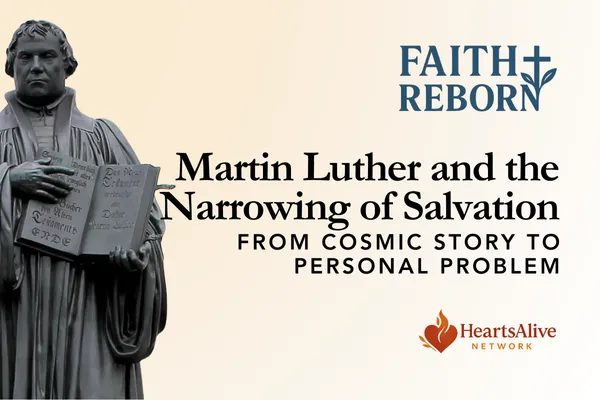
Martin Luther and the Narrowing of Salvation: From Cosmic Story to Personal Problem
When Martin Luther hammered his 95 Theses to the church door in Wittenberg in 1517, he set off shockwaves that reshaped Europe. That spark not only reignited grace but also narrowed salvation into an individual issue to be resolved, eclipsing the larger story of covenant and new creation.
Luther was a monk tormented by guilt, desperate to know how he could find peace with God. He tried fasting, confession, penance—but nothing eased his troubled conscience. His breakthrough came while studying Romans—especially Romans 1:17: “The righteous shall live by faith.” He saw that salvation was not earned but given, received by faith. Justification was by grace alone, not mediated by priests or purchased with indulgences.
This discovery shook the medieval church. The message spread like wildfire through the new technology of the printing press. Suddenly pamphlets, tracts, and even the Scriptures themselves—still primarily in the legal-soaked language of the Latin translation of scripture—were being placed into the hands of ordinary believers.
For the first time, many could see and wrestle with the text directly, even if filtered through inherited frameworks. Luther challenged Rome’s power, toppled the system of indulgences, and opened the Scriptures to ordinary believers. Yet in all of this, Luther both recovered something essential and reinforced distortions that shrank the gospel.
The Big Story That Got Lost
The Scriptures tell a sweeping story: creation called good, covenant made with Abraham, Israel chosen, Messiah crucified and raised, resurrection as the beginning of new creation, and the promise of heaven and earth reunited. This is the biblical hope: not Plato's vision of souls escaping earth, but God dwelling with his people in a renewed creation.
Yet centuries before Luther, this cosmic story had already begun to shrink. Influenced by Greek philosophy, early Christians imagined salvation as the escape of the soul from the body. Augustine sharpened the focus further, defining the human problem as inherited guilt. By the Middle Ages, the church cast itself as manager of souls, dispensing grace to individuals on their journey to heaven.
Luther’s Recovery—and Narrowing
Luther rightly saw through the corruption. He recovered grace as a free gift. But for him, salvation was still a personal problem: How can I find a gracious God? How can my guilty conscience be acquitted?
The courtroom became the primary image. Man broke God's law. Man was guilty. Punishment was required. Jesus paid the price.
Justification was a legal verdict, not the launch of new creation.
Faith was reduced to trust in the verdict, rather than embodied loyalty to the risen King, the Good Father, and The Holy Spirit.
In this narrowing, Luther reinforced a distortion: salvation became about me and my soul, not about God’s covenant fulfilled and the renewal of all creation.
Weaponizing Scripture
Inside this narrow frame, Scripture itself began to be weaponized. In reality, most people were trying to square up what they read with what they had been taught by the Roman church. Old categories still shaped new discoveries. This meant the text was often pressed into the service of confirming inherited assumptions rather than opening the door to the larger story.
The context of early 1500s Europe only heightened this dynamic. The continent was fragmented politically, torn by local wars and shifting alliances. The Holy Roman Empire was struggling to hold its patchwork of territories together. The Renaissance had stirred new confidence in reason and humanism. At the same time, social unrest simmered—peasant revolts, economic pressures, and new towns and trades disrupting old orders.
The Peasants’ War of 1524–25, inspired in part by appeals to Scripture, showed how quickly the Bible could be marshaled to justify revolution. Humanists like Erasmus urged a return to the sources, sharpening both scholarship and debate. In this ferment, In that turbulence, Scripture became both a lifeline and a weapon: a way to assert authority, defend tradition, or justify rebellion.
Verses were stripped from the story and turned into prooftexts about how the individual is saved.
Paul’s letters, which wrestle with Jew/Gentile unity and God’s covenant faithfulness, were reduced to personal “plans of salvation.”
The grand hope of resurrection and the renewal of all things collapsed into fire insurance for the soul.
The Legacy
Luther’s Reformation tore down the walls of a corrupt church system, but it did not rebuild the broader biblical narrative of covenant and creation. Instead, salvation remained locked inside the framework of guilt, verdict, and escape.
The long-term effect was profound:
Individualized Faith: Christianity became focused on the individual conscience rather than the communal story of God’s people and the renewal of creation.
Courtroom Framework Entrenched: The legal metaphor of guilt and acquittal became the dominant lens for understanding the gospel, sidelining resurrection and new creation.
Fragmentation of the Church: By placing Scripture in the hands of all, but without recovering the unifying story, divisions multiplied. Competing interpretations fueled denominational splits that continue to this day.
Hope Reduced: Instead of anticipating heaven and earth renewed, the focus turned toward securing assurance of a place in heaven after death.
Five hundred years later, we still live in this legacy. We inherited a gospel of grace—but a grace trapped inside a shrunken story. The pressing question is whether we will move beyond the courtroom and rediscover the expansive hope of resurrection, covenant, and new creation.


